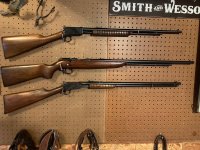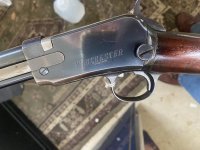That'd be the 61....
wouldn't it?
An abbreviated history of the 1890, 1906, 61 and 62:
Model 1890
The 1890 was designed for the .22 Winchester Rim Fire, and was commonly chambered as well in .22 Short and .22 Long. Despite coming out in 1887, Winchester was resistant to the .22 LR, apparently backing its own .22 WRF in favor of the .22 LR.
It wasn’t a bad plan as the 1890 was unique in being lightweight, slick in operation and fairly inexpensive with little repeater competition at the time. There was the heavier, more expensive and occasionally problematic Colt Lighting, and the more expensive Marlin 1891, and I think Winchester felt it’s larger share of the market and .22 WRF would prevail over the .22 LR.
Winchester didn’t chamber a rifle in .22 LR until 1907 and then it was in the 1906 rifle. They didn’t chamber the 1890 in .22 LR until 1919, and it has always been an uncommon cartridge for an 1890.
Another aspect of it is that the 1890 design required different lifters to function with the four different length cartridges, so there was no interchangeability within a single rifle.
The first model 1890s had solid frames and fixed sights, with about 15,000 produced in the first 2 years of production.
The second model introduced the take down design and had an adjustable sight. IIRC about 100,000 of these were sold before they switched from color case hardened to blued steel receivers around 1901.
The third model was introduced in 1907 after the economy model 1906. It had the same externally visible locking lugs as the 1906 and later 62. The 1890 was produced along side the 1906 until 1932 when both were replaced by the Model 62.
The third model 1890 comprised the remaining 500,000 or so of the 840,000 or so 1890s produced in total from 1890-1932. There were also a few 1890s made until 1941 from left over parts.
The 1890 was available with different options but the standard was a 24” octagon barrel and straight stock.
Model 1906
The 1906 was an economy model of the 1890, with a 20” round rather than octagon barrel, a flat shot gun butt rather than the crescent butt plate and a slightly shorter length of pull. The first 100,000 or so produced in 1906-1907 in .22 Short only. They were priced at $8.50 at the time, compared to $10.50 for the 1890.
In 1907 Winchester started chambering the 1906 in .22 S, L, LR as a grudging nod that the .22 LR was here to stay and essential for the 1906 to be competitive.
About 750,000 were produced before it and the 1890 were discontinued in 1932, although a few more were made from left over parts until 1936.
Model 62
In 1932 Olin acquired Winchester, and introduced the Model 61 and Model 62. The Model 62 was an updated 1890 chambered in .22 S, L and LR, with a 23” round barrel. It was available in a few different grades in the catalog but like all the Olin era Winchesters was not available with many options and in this case no options. The fore end was a little longer than the 1890, but not much. The 62A got coil springs and a longer fore end.
In keeping with the 1890 and 1906 there was also a .22 Short only gallery model with the triangular shaped loading port to accommodate the loading tubes used by galleries.
Winchester made roughly 490,000 of them before it was discontinued in 1958. The 1890, 1906 and 62 and 62A together compromised about 2 million exposed hammer pump action rimfires.
Model 61:
The Model 61 was the first hammerless Winchester pump action and Winchester was late to the party. Savage had one starting in 1903 and Remington Came out with the Model 12 in 1909.
Winchester and John Browning (who designed the 1890) parted ways in 1902 and Browbing had designed a pump action rimfire for FN in 1922, so Winchester had to be careful about patent infringement. Plus the traditional hammer designs were selling well, so Winchester wasn’t in a hurry until about 1930. Even then it introduced the Model 62 along side the Model 61 and kept the 62 until 1958.
The 61 was primarily chambered in .22 S, L and LR, with a small number of . 22 Short only, as well as a small number in .22 WRF and a small number of late production rifles in .22 WMR (the first .22 WMR rifles on the market). In the mid 1950s they started grooving the receiver for top off scope mounts.
About 344,000 were made before it was discontinued in 1963, but interestingly enough the same basic bolt design and feed system was used 9 years later in the 9422 with relatively little modification.



















